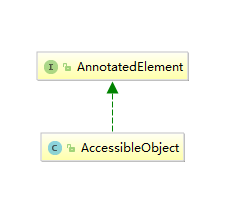java基础源码 (4)--reflect包-AnnotatedElement接口

接口:AnnotatedElement
* Represents an annotated element of the program currently running in this
* VM. This interface allows annotations to be read reflectively. All
* annotations returned by methods in this interface are immutable and
* serializable. The arrays returned by methods of this interface may be modified
* by callers without affecting the arrays returned to other callers.
表示当前在此虚拟机中运行的程序的注释元素,该界面允许反射读取注释,通过该接口方法返回的所有注释
都是不可变并且可序列化。通过此接口的方法返回的陈列可以由呼叫着,而不会影响其他调用者返回阵列进行修改。
*/
public interface AnnotatedElement {
/**
* Returns true if an annotation for the specified type
* is <em>present</em> on this element, else false. This method
* is designed primarily for convenient access to marker annotations.
如果此元素上存在指定类型的注释,则返回true,否则返回false,该方法主要用于方便
访问标记注释
*/
default boolean isAnnotationPresent(Class<? extends Annotation> annotationClass) {
return getAnnotation(annotationClass) != null;
} /**
* Returns this element's annotation for the specified type if
* such an annotation is <em>present</em>, else null.
如果这样的注解存在,就返回该注解,否则返回Null*/
<T extends Annotation> T getAnnotation(Class<T> annotationClass); /**
* Returns annotations that are <em>present</em> on this element.
*返回此元素上存在的注解
*/
Annotation[] getAnnotations(); /**
* Returns annotations that are <em>associated</em> with this element.
返回与此注解相关联的注解*/
default <T extends Annotation> T[] getAnnotationsByType(Class<T> annotationClass) {
//默认的调用getDeclaredAnnotationsByte传入annotationClass作为参数
T[] result = getDeclaredAnnotationsByType(annotationClass);
//如果返回的数组长度大于零,则返回数组,
//如果返回的数组是零长度而这个AnnotationElement是一个类,
//并且参数类型是可继承的注解类型,并且该AnnotatedElement的AnnotatedElement是非空的
//则返回结果是在父类上调用getAnnotationsByType的结果,具有annotationClass作为论证
//否则返回零长度的数组
if (result.length == 0 && // Neither directly nor indirectly present
this instanceof Class && // the element is a class
AnnotationType.getInstance(annotationClass).isInherited()) { // Inheritable
Class<?> superClass = ((Class<?>) this).getSuperclass();
if (superClass != null) {
// Determine if the annotation is associated with the
// superclass
result = superClass.getAnnotationsByType(annotationClass);
}
} return result;
} /**
* Returns this element's annotation for the specified type if
* such an annotation is <em>directly present</em>, else null.
如果这样的注解直接存在,则返回指定类型的元素注解,否则返回null,此方法忽略继承的注解*/
default <T extends Annotation> T getDeclaredAnnotation(Class<T> annotationClass) {
Objects.requireNonNull(annotationClass);
// Loop over all directly-present annotations looking for a matching one
for (Annotation annotation : getDeclaredAnnotations()) {
if (annotationClass.equals(annotation.annotationType())) {
//更强大,在编译期间进行动态转换
return annotationClass.cast(annotation);
}
}
return null;
} default <T extends Annotation> T[] getDeclaredAnnotationsByType(Class<T> annotationClass) {
Objects.requireNonNull(annotationClass);
return AnnotationSupport.
getDirectlyAndIndirectlyPresent(Arrays.stream(getDeclaredAnnotations()).
collect(Collectors.toMap(Annotation::annotationType,
Function.identity(),
((first,second) -> first),
LinkedHashMap::new)),
annotationClass);
} /**
* Returns annotations that are <em>directly present</em> on this element.
* This method ignores inherited annotations.
返回直接存在于此元素上的注释*/
Annotation[] getDeclaredAnnotations();
}
isAnnotationPresent方法的示例:
@Retention(RetentionPolicy.RUNTIME)
@interface Cus{
public String name();
public String value();
} @Cus(name = "SampleClass",value = "Sample Class Annotation")
class SampClass{
private String sampleFileld;
@Cus(name = "sampleMethod",value = "sample Method Annotation")
public String sampleMethod(){
return "sample";
}
public String getSampleFileld(){
return sampleFileld;
}
public void setSampleFileld(String sa){
this.sampleFileld=sa;
}
} public class AccessibleObjectDemo {
public static void main(String [] args) throws NoSuchMethodException {
AccessibleObject sampleMethod = SampClass.class.getMethod("sampleMethod");
System.out.println("sampleMethod.isAnnotationPresent:"+sampleMethod.isAnnotationPresent(Cus.class));
//输出结果:sampleMethod.isAnnotationPresent:true
}
}
getAnnotations()示例:
@Retention(RetentionPolicy.RUNTIME)
@interface Tt{
public String name();
public String value();
} @Tt(name = "SampleClass",value = "Sample Class Annotation")
class SampClass2{
private String sampleFileld;
@Tt(name = "sampleMethod",value = "sample Method Annotation")
public String sampleMethod(){
return "sample";
}
public String getSampleFileld(){
return sampleFileld;
}
public void setSampleFileld(String sa){
this.sampleFileld=sa;
}
} public class AccessibleObjectDemo2 {
public static void main(String [] args) throws NoSuchMethodException {
AccessibleObject sampleMethod = SampClass2.class.getMethod("sampleMethod");
Annotation[] annotations = sampleMethod.getAnnotations(); for(int i=0;i<annotations.length;i++){
if(annotations[i] instanceof Tt){
Tt cus2= (Tt) annotations[i];
System.out.println(cus2.name());
System.out.println(cus2.value());
/*
输出结果:
sampleMethod
sample Method Annotation
* */
}
}
}
}
java基础源码 (4)--reflect包-AnnotatedElement接口的更多相关文章
- java基础源码 (5)--reflect包-AccessibleObject类
学习参考博客:https://blog.csdn.net/benjaminzhang666/article/details/9664585AccessibleObject类基本作用 1.将反射的对象标 ...
- java基础源码 (6)--ArrayListt类
原作出处:https://www.cnblogs.com/leesf456/p/5308358.html 简介: 1.ArrayList是一个数组队列,相当于动态数组.与java中的数组相比,它的容量 ...
- java基础源码 (1)--String类
这个是String类上面的注释,我用谷歌翻译翻译的,虽然有点语法上的问题,但是大概都可以翻译出来 /** * The {@code String} class represents character ...
- java基础源码 (3)--Annotation(注解)
借鉴博客地址:https://www.cnblogs.com/skywang12345/p/3344137.html /** * The common interface extended by al ...
- java基础源码 (2)--StringBuilder类
Serializable(接口): 是一个IO的序列化接口,实现了这个接口,就代表这个类可以序列化或者反序列化,该接口没有方法或者字段,仅用于标识可串行话的语义. Appendable(接口): /* ...
- 自学Java HashMap源码
自学Java HashMap源码 参考:http://zhangshixi.iteye.com/blog/672697 HashMap概述 HashMap是基于哈希表的Map接口的非同步实现.此实现提 ...
- java容器源码分析及常见面试题笔记
概览 容器主要包括 Collection 和 Map 两种,Collection 存储着对象的集合,而 Map 存储着键值对(两个对象)的映射表. List Arraylist: Object数组 ...
- Java集合源码分析(三)LinkedList
LinkedList简介 LinkedList是基于双向循环链表(从源码中可以很容易看出)实现的,除了可以当做链表来操作外,它还可以当做栈.队列和双端队列来使用. LinkedList同样是非线程安全 ...
- Java集合源码学习(一)集合框架概览
>>集合框架 Java集合框架包含了大部分Java开发中用到的数据结构,主要包括List列表.Set集合.Map映射.迭代器(Iterator.Enumeration).工具类(Array ...
随机推荐
- 新闻网大数据实时分析可视化系统项目——5、Hadoop2.X HA架构与部署
1.HDFS-HA架构原理介绍 hadoop2.x之后,Clouera提出了QJM/Qurom Journal Manager,这是一个基于Paxos算法实现的HDFS HA方案,它给出了一种较好的解 ...
- windows环境变量引发的血案
最近重装了系统,决心使用Anaconda来管理python包和虚拟环境.在完成一系列配置后,运行程序,发现老是报错 D:\Anaconda3\envs\jobnote>python E:\wor ...
- python设置编码
import sys sys.getdefaultencoding() #看到默认编码是'ascii' #通常需要的是使用utf8编码,需要这样做: reload(sys) sys.setdefaul ...
- Redis详解(一)——RDB
Redis详解(一)--RDB 前言 由于 Redis 是一个内存数据库,所谓内存数据库,就是将数据库中的内容保存在内存中,这与传统的MySQL,Oracle等关系型数据库直接将内容保存到硬盘中相比, ...
- oracle数据库的完整性约束规则详解
CSDN日报20170303--<百亿互金平台救火故事> 程序员2月书讯 社区有奖问答--一起舞动酷炫的iOS动画 基于Spark的分布式深度学习和认知计算 oracle数据库的完 ...
- css常用设置
距离左边和上边 style="margin-left:100px;margin-top:10px" 设置相对位置 position:absolute; position:relat ...
- 15 SQL中的安全问题
SQL中的安全问题 1.SQL注入 demo1: SELECT * FROM user WHERE username = ? AND password ...
- python操作mongoDB(pymongo的使用)
pymongo操作手册 连接数据库 方法一(推荐) import pymongo client = pymongo.MongoClient(host="localhost",por ...
- jenkins -- 安装、任务构建
一.jenkins是什么? Jenkins是一个开源的.提供友好操作界面的持续集成(CI)工具,起源于Hudson(Hudson是商用的),主要用于持续.自动的构建/测试软件项目.监控外部任务的运行( ...
- spring事物(一),@EnableTransactionManagement @Transactional 启动解析
1.事物的声明阶段 @EnableTransactionManagement,是我们开启注解事物的第一步,我们来看下这个类为我们干了什么 @Target(ElementType.TYPE) @Rete ...
